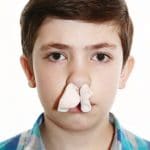

Dr. IssamInjaq
As summer approaches and the weather gets warmer, children may suffer diarrhea and vomiting. Diarrhea is known as a change in the stool where it is discharged from the bowels frequently and in a loose and liquid form. Other changes include a change in the color and smell.
Normal children poop once to twice a day and the stool is solid and yellow. In diarrhea, however, the color turns green or blackish and the child goes to the toilet four times or more every day.
Diarrhea could be chronic or acute.
Chronic diarrhea lasts formore than 14 days. Reasons for this kind of diarrhea are different from those causing the acute diarrhea. If not treated properly, acute diarrhea could turn into chronic diarrhea, causing weight loss and a delay in the child’s development.
Acute diarrhea, however, is usually a result of infectious agents. Diarrhea pathogens differ between summer and winter. In winter, for instance, diarrhea is usually caused by filterable viruses, while in summer, it is caused by germs or bacterial toxins, i.e. food poisoning.
Causes of Gastritis:
Gastritis occurs when pathogens reach the stomach and intestines orally. It is usually caused by food or water contamination or hand germ contamination. These germs exit the body via the stool, and spread to infect other children, especially in summer.
Diarrheais often accompanied bythirst and the need to drink water, but the patient may not be able to drink water because of vomiting, which leads to dehydration, the most dangerous aspect of diarrhea.
Water makes up a significant percentage of the body, especially for children. Losinglots of body liquids due to diarrhea and failure to compensate this loss because of vomiting or lack of absorption in the intestines leads to dehydration and lack of water content in the body, resulting in other problems such as hypotension and tachycardia. Body minerals could also be affected, which could cause disruption in functions of some body cells.
Diarrhea and Vomiting Treatment
The main course of acute gastroenteritis treatment is giving the patient fluids and normal saline.
In case of diarrhea not accompanied by vomiting, where the loss of liquids is limited or medium, the loss can be compensated by drinking water and fluids.
Sachets of minerals necessary to compensate for loss of fluids in the body are commercially available. They are diluted by water and given to the children. Other solutions are ready-packed and sterile, and can be given directly to children.
However, when diarrhea is accompanied by vomiting, or when the dehydration is acute and the loss of fluids is fast, the compensation must be fast as well. The patient must be hospitalized and the fluid is given through an intravenous line. The patient must remain under observation.
In addition to water and fluids, patients might receive medication, like anti-vomiting, antipyretics and antispasmodics, to relieve abdominal pain. Antibiotics, however, must be prescribed by a doctor, depending on the case. While many cases of acute gastroenteritis are cured without antibiotics, some require antibiotics when the illness is severe, or if the patient is a baby, suffers immunity disorder or malnutrition, or when pathogens attack the lining of the stomach. Giving the patient antibiotics when not necessary may lead to undesired side effects.
An ounce of prevention is worth a pound of cure. Hygiene, hence, is the best way to prevent infections of acute gastroenteritis. Washing the hands after using the bathroom or changing the baby’s diaper or before preparing or eating food is essential for prevention. Children must also be prevented from eating uncovered food, which is exposed to insects; especially flies that increase in the summer and transmit pathogens. Poor food preservation helps boost the proliferation of germs and pathogens, which can survive cold temperatures in the refrigerator. When exposed to heat, the germs proliferate and enter the body via the gastrointestinal tract, leading to acute gastroenteritis.
http://www.altibbi.com









